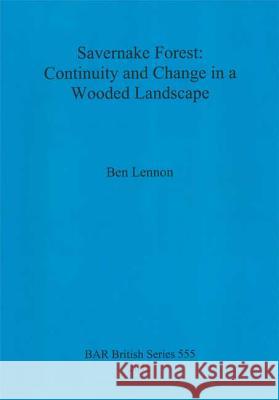Savernake Forest: Continuity and Change in a Wooded Landscape » książka
Savernake Forest: Continuity and Change in a Wooded Landscape
ISBN-13: 9781407309460 / Angielski / Miękka / 2012 / 190 str.
The objective of this study is to seek to better understand the processes involved in landscape change that have resulted in the highly distinctive character types found in the British Isles. Rather than drawing examples of different aspects of development from around the regions, a single heavily wooded landscape has been chosen for study, that of Savernake Forest (Wiltshire, southern England). The case is made that the processes involved in landscape dynamics are universally applicable, but that the various factors interact in subtly different ways in order to create distinctive landscape signatures. This can create highly contrasting landscape types within relatively short distances. While these are general observations on the nature of landscape, the study aims to show that heavily wooded landscapes, even those that we regard as rich in ancient woodland, are no less dynamic than their more open counterparts. The study uses a range of techniques from different disciplines to build up a picture of rural landscape features and seeks to put them into a comprehensible context within a chronological narrative. Whereas much of the foregoing focus has looked at settlement pattern, what is of interest to this study is the places in between settlements, especially where these lie outside the widely accepted and recognised pattern of gradual enclosure and agricultural intensification. Some of the techniques used in this study are traditional, whilst others are still emerging and in development. By considering all of the evidence we can increase the depth of understanding of past and present landscapes. From such a point it may be possible to contemplate the management and direction of future landscapes.
The objective of this study is to seek to better understand the processes involved in landscape change that have resulted in the highly distinctive character types found in the British Isles. Rather than drawing examples of different aspects of development from around the regions, a single heavily wooded landscape has been chosen for study, that of Savernake Forest (Wiltshire, southern England). The case is made that the processes involved in landscape dynamics are universally applicable, but that the various factors interact in subtly different ways in order to create distinctive landscape signatures. This can create highly contrasting landscape types within relatively short distances. While these are general observations on the nature of landscape, the study aims to show that heavily wooded landscapes, even those that we regard as rich in ancient woodland, are no less dynamic than their more open counterparts. The study uses a range of techniques from different disciplines to build up a picture of rural landscape features and seeks to put them into a comprehensible context within a chronological narrative. Whereas much of the foregoing focus has looked at settlement pattern, what is of interest to this study is the places in between settlements, especially where these lie outside the widely accepted and recognised pattern of gradual enclosure and agricultural intensification. Some of the techniques used in this study are traditional, whilst others are still emerging and in development. By considering all of the evidence we can increase the depth of understanding of past and present landscapes. From such a point it may be possible to contemplate the management and direction of future landscapes.











